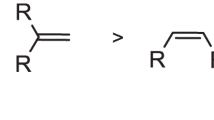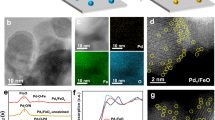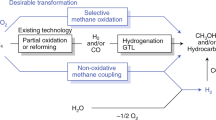Abstract
Slurry-phase Fischer–Tropsch catalysis is widely used in the production of synthetic transportation fuels, but places severe stresses on the catalyst due to the demanding hydrothermal and mechanical reaction conditions. In this Article we report the synthesis, characterization and catalytic performance of a robust cobalt-based Fischer–Tropsch catalyst. Combining an inert alpha alumina support with an appropriate cobalt addition method produces a material that is easy to reduce without precious metal additives and is mechanically and hydrothermally stable. Unlike many Fischer–Tropsch catalysts, this material is resistant to sintering and shows excellent selectivity and good activity in slurry-phase testing over 1,000 hours.
This is a preview of subscription content, access via your institution
Access options
Access Nature and 54 other Nature Portfolio journals
Get Nature+, our best-value online-access subscription
$29.99 / 30 days
cancel any time
Subscribe to this journal
Receive 12 digital issues and online access to articles
$119.00 per year
only $9.92 per issue
Buy this article
- Purchase on Springer Link
- Instant access to full article PDF
Prices may be subject to local taxes which are calculated during checkout





Similar content being viewed by others
Data availability
The data that support the plots within this paper, and other findings of this study, are available from the corresponding author upon reasonable request.
References
de Klerk, A. in Future Energy: Improved, Sustainable and Clean Options for our Planet 2nd edn (ed. Letcher, T. M.) Ch. 12 (Elsevier, 2014).
Khodakov, A. Y., Chu, W. & Fongarland, P. Advances in the development of novel cobalt Fischer−Tropsch catalysts for synthesis of long-chain hydrocarbons and clean fuels. Chem. Rev. 107, 1692–1744 (2007).
Jothimurugesan, K. Stable support for Fischer–Tropsch catalyst. US patent 9,370,768 B2 (2014).
Rytter, E. & Holmen, A. Deactivation and regeneration of commercial type Fischer–Tropsch co-catalysts—a mini-review. Catalysts 5, 478–499 (2015).
Perego, C., Bortolo, R. & Zennaro, R. Gas to liquids technologies for natural gas reserves valorization: the Eni experience. Catal. Today 142, 9–16 (2009).
Antonini, A. M., Mercer, R. J. & Neale, A. F. Catalysts supports. US patent application 20160375424 A1 (2016).
Ortego, J. D. Jr, Jothimurugesan, K., Espinoza, R. L., Coy, K. L. & Ortego, B. C. Fischer–Tropsch processes and catalysts using stabilized supports. US patent 7,071,239 B2 (2006)
Enger, B. C., Fossan, A.-L., Borg, Ø., Rytter, E. & Holmen, A. Modified alumina as catalyst support for cobalt in the Fischer–Tropsch synthesis. J. Catal. 284, 9–22 (2011).
Maciver, D. S., Tobin, H. H. & Barth, R. T. Catalytic aluminas I. Surface chemistry of eta and gamma alumina. J. Catal. 2, 485–497 (1963).
Bhasin M. M. & Jarell, M. S. Catalysts comprising substantially pure alpha alumina carrier for treating exhaust gases. US patent 5,856,263 (1999).
Johnson, B. R. et al. Engineered SMR catalysts based on hydrothermally stable, porous, ceramic supports for microchannel reactors. Catal. Today 120, 54–62 (2007).
Munirathinam, R., Pham Minh, D. & Nzihou, A. Effect of the support and its surface modifications in cobalt-based Fischer–Tropsch synthesis. Ind. Eng. Chem. Res. 57, 16137–16161 (2018).
Eri, S., Kinnari, K. J., Schanke, D. & Hilmen, A.-M. Fischer–Tropsch catalyst, preparation and use thereof. US patent 7,351,679 (2008).
Ellis, P. R. Cobalt catalyst precursor. International Patent Application WO 2010/049715A1 (2010).
Lok, C. M., Kelly, G. J. & Gray, G. Catalysts with high cobalt surface area. US patent 6,927,190 B2 (2005).
Lok, C. M. Novel highly dispersed cobalt catalysts for improved Fischer–Tropsch productivity. Stud. Surf. Sci. Catal. 147, 283–288 (2004).
Schlessinger, G., Simmons, J. W., Jabs, G. & Chamberlain, M. M. Carbonatotetramminecobalt(iii) nitrate. Inorg. Synth. 6, 173–175 (1966).
Schanke, D. et al. Study of Pt-promoted cobalt CO hydrogenation catalysts. J. Catal. 156, 85–95 (1995).
Eschemann, T. O. et al. Effect of support surface treatment on the synthesis, structure and performance of Co/CNT Fischer Tropsch catalysts. J. Catal. 328, 130–138 (2015).
Eschemann, T. O. & de Jong, K. P. Deactivation behavior of Co/TiO2 catalysts during Fischer–Tropsch synthesis. ACS Catal. 5, 3181–3188 (2015).
Zhao, Y.-H. et al. Direct synthesis of the reduced Co-C/SiO2 as an efficient catalyst for Fischer–Tropsch synthesis. Ind. Eng. Chem. Res. 57, 1137–1145 (2018).
Iglesia, E. Design, synthesis and use of cobalt-based Fischer–Tropsch synthesis catalysts. Appl. Catal. A 161, 59–78 (1997).
Houska, C. R., Averbach, B. L. & Cohen, M. The cobalt transformation. Acta Metall. 8, 81–87 (1960).
Andreev, A. S., d’Espinose de Lacaillerie, J.-B., Lapina, O. B. & Gerashenko, A. Thermal stability and hcp–fcc allotropic transformation in supported Co metal catalysts probed near operando by ferromagnetic NMR. Phys. Chem. Chem. Phys. 17, 14598–14604 (2015).
Price, S. W. T. et al. Chemical imaging of Fischer–Tropsch catalysts under operating conditions. Sci. Adv. 3, e1602838 (2017).
Boudart, M. & McDonald, M. A. Structure sensitivity of hydrocarbon synthesis from carbon monoxide and hydrogen. J. Phys. Chem. 88, 2185–2195 (1984).
Fu, L. & Bartholomew, C. H. Structure sensitivity and its effects on product distribution in CO hydrogenation on cobalt/alumina. J. Catal. 92, 376–387 (1985).
Wang, Z.-j, Liu, C.-j & Goodman, D. W. Surface science studies on cobalt Fischer–Tropsch catalysts. ChemCatChem 3, 551–559 (2011).
van Helden, P., Ciobîcă, I. M. & Coetzer, R. L. J. The size dependent site composition of FCC cobalt nanocrystals. Catal. Today 261, 48–59 (2016).
den Breejen, J. P. et al. On the origin of the cobalt particle size effects in Fischer–Tropsch catalysis. J. Am. Chem. Soc. 131, 7197–7203 (2009).
Cheng, J. et al. A quantitative determination of reaction mechanisms from density functional theory calculations: Fischer–Tropsch synthesis on flat and stepped cobalt surfaces. J. Catal. 254, 285–295 (2008).
Huo, C.-F., Li, Y.-W., Wang, J. & Jiao, H. Formation of CHx species from CO dissociation on double-stepped Co(0001): exploring Fischer–Tropsch mechanism. J. Phys. Chem. C 112, 14108–14116 (2008).
Tsakoumis, N. E. et al. Fischer–Tropsch synthesis: an XAS/XRPD combined in situ study from catalyst activation to deactivation. J. Catal. 291, 138–148 (2012).
Cats, K. H. & Weckhuysen, B. M. Combined operando X-ray diffraction/Raman spectroscopy of catalytic solids in the laboratory: the Co/TiO2 Fischer–Tropsch synthesis catalyst showcase. ChemCatChem 8, 1531–1542 (2016).
Andreev, A. S., Lapina, O. B., d’Espinse de Lacaillerie, J.-B. & Khassin, A. A. Effect of alumina modification on the structure of cobalt-containing Fischer–Tropsch synthesis catalysts according to internal field 59Co NMR. Data J. Struct. Chem. 54, S102–S110 (2013).
Enache, D. I., Rebours, B., Roy-Auberger, M. & Revel, R. In-situ XRD study of the influence of thermal treatment on the characteristics and the catalytic properties of cobalt-based Fischer–Tropsch catalysts. J. Catal. 205, 346–353 (2002).
Karaca, H. et al. Structure and catalytic performance of Pt-promoted alumina-supported cobalt catalysts under realistic conditions of Fischer–Tropsch synthesis. J. Catal. 277, 14–26 (2011).
Xia, Y., Dai, H., Jiang, H. & Zhang, L. Three-dimensional ordered mesoporous cobalt oxides: highly active catalysts for the oxidation of toluene and methanol. Catal. Commun. 11, 1171–1175 (2010).
van de Loosdrecht, J., Barradas, S., van Berge, P. J. & Visagie, J. L. Support modification of cobalt based slurry phase Fischer–Tropsch catalysts. ACS Div. Fuel Chem. Prepr. 45, 587–591 (2000).
Jacobs, G. et al. Fischer–Tropsch synthesis: temperature programmed EXAFS/XANES investigation of the influence of support type, cobalt loading, and noble metal promoter addition to the reduction behavior of cobalt oxide particles. Appl. Catal. A 333, 177–191 (2007).
Magrini-Bair, K. A. et al. Fluidizable reforming catalyst development for conditioning biomass-derived syngas. Appl. Catal. A 318, 199–206 (2007).
Greenwood, N. N. & Earnshaw, A. in Chemistry of the Elements 273–277 (Pergamon Press, 1984).
Magistro, A. J. Attrition resistant catalyst support. US patent 5,037,794 (1991).
ASTM D5757-95: Standard Test Method for Determination of Attrition and Abrasion of Powdered Catalysts by Air Jets (ASTM, 1995).
de Klerk, A. Fischer–Tropsch fuels refinery design. Energy Environ. Sci. 4, 1177 (2011).
Dalai, A. K. & Davis, B. H. Fischer–Tropsch synthesis: a review of water effects on the performances of unsupported and supported Co catalysts. Appl. Catal. A 348, 1–15 (2008).
Roth, W. L. J. The magnetic structure of Co3O4. J. Phys. Chem. Solids 25, 1–10 (1964).
Sadeqzadeh, M. et al. Deactivation of a Co/Al2O3 Fischer–Tropsch catalyst by water-induced sintering in slurry reactor: modeling and experimental investigations. Catal. Today 215, 52–59 (2013).
Hosseini, S. A., Taeb, A., Feyzi, F. & Yaripour, F. Fischer–Tropsch synthesis over Ru-promoted Co/γ-Al2O3 catalysts in a CSTR. Catal. Commun. 5, 137–143 (2004).
Li, J. et al. Fischer–Tropsch synthesis: effect of water on the deactivation of Pt promoted Co/Al2O3 catalysts. Appl. Catal. A 228, 203–212 (2002).
Gnanamani, M. K. et al. Ga and In modified ceria as supports for cobalt-catalyzed Fischer Tropsch synthesis. Appl. Catal. A 547, 115–123 (2017).
Ma, W. et al. Fischer–Tropsch synthesis: kinetics and water effect study over 25% Co/Al2O3 catalysts. Catal. Today 228, 158–166 (2014).
Eri, S., Kinnari, K. J., Schanke, D. & Hilmen, A.-M. Fischer–Tropsch catalyst with low surface area alumina, its preparation and use thereof. US patent application 2004/0077737A1 (2004).
Lögdberg, S. et al. Effect of water on the space-time yield of different supported cobalt catalysts during Fischer Tropsch synthesis. Appl. Catal. A 393, 109–121 (2011).
Moodley, D. J. et al. Carbon deposition as a deactivation mechanism of cobalt-based Fischer–Tropsch synthesis catalysts under realistic conditions. Appl. Catal. A 354, 102–110 (2009).
Jacobs, G., Patterson, P. M., Das, T. K., Luo, M. & Davis, B. H. Fischer–Tropsch synthesis: effect of water on Co/Al2O3 catalysts and XAFS characterization of reoxidation phenomena. Appl. Catal. A Gen. 270, 65–76 (2004).
Tsakoumis, N. E., Rønning, M., Borg, Ø., Rytter, E. & Holmen, A. Deactivation of cobalt-based Fischer–Tropsch catalysts: a review. Catal. Today 154, 162–182 (2010).
van Berge, P. J., van de Loosdrecht, J., Barradas, S. & van der Kraan, A. M. Oxidation of cobalt based Fischer–Tropsch catalysts as a deactivation mechanism. Catal. Today 58, 321–334 (2000).
Saib, A. M. et al. Fundamental understanding of deactivation and regeneration of cobalt Fischer–Tropsch synthesis catalysts. Catal. Today 154, 271–282 (2010).
Clarkson, J. et al. Deactivation of alumina supported cobalt FT catalysts during testing in a continuous-stirred tank reactor. Appl. Catal. A 550, 28–37 (2018).
Overett, M. J., Breedt, B., du Plessis, E., Erasmus, W. & van de Loosdrecht, J. Sintering as a deactivation mechanism for an alumina supported cobalt Fischer Tropsch synthesis catalyst. Prep. Pap. Am. Chem. Soc. Div. Petr. Chem. 53, 126–128 (2008).
Munnik, P., de Jongh, P. E. & de Jong, K. P. Control and impact of the nanoscale distribution of supported cobalt particles used in Fischer–Tropsch catalysis. J. Am. Chem. Soc. 136, 7333–7340 (2014).
Chambrey, S. et al. Fischer Tropsch synthesis in milli-fixed bed reactor: comparison with centrimetric fixed bed and slurry stirred tank reactors. Catal. Today 171, 201–206 (2011).
Reuel, R. & Bartholomew, C. H. The stoichiometries of H2 and CO adsorptions on cobalt: effects of support and preparation. J. Catal. 85, 63–77 (1984).
Acknowledgements
The authors acknowledge various colleagues at Johnson Matthey for their help with analysis relating to this paper: M. Gregory and P. Fisher (ICP); H. Jobson, J. McNaught, E. Bilbé, K. Simmance and H. Marchbank (XRD); S. Longworth, M. Briceno, S. Spratt, A. Phillips and D. Trung Trang (electron microscopy); N. Barrow and M. Johnson (NMR); C. Baptist (GC analysis); P.J. Ellis (TPH). The authors are especially grateful to J. Foise and M. Francis of Saint Gobain Norpro for supplying the alpha alumina materials used in this work, arranging the steaming experiments, and for many insightful discussions.
Author information
Authors and Affiliations
Contributions
P.R.E. made the catalysts, performed and coordinated the characterization studies. D.S.J. and D.W.J. performed fixed-bed tests and analysed the results. D.I.E. performed slurry-phase testing and analysed the results. G.J.K. led the research programme. P.R.E. coordinated the production of the manuscript, to which all authors contributed.
Corresponding author
Ethics declarations
Competing interests
The authors declare no competing interests.
Additional information
Publisher’s note: Springer Nature remains neutral with regard to jurisdictional claims in published maps and institutional affiliations.
Supplementary information
Supplementary Information
Supplementary methods, Supplementary Figs. 1–19, Supplementary Tables 1–10, Supplementary references.
Rights and permissions
About this article
Cite this article
Ellis, P.R., Enache, D.I., James, D.W. et al. A robust and precious metal-free high performance cobalt Fischer–Tropsch catalyst. Nat Catal 2, 623–631 (2019). https://doi.org/10.1038/s41929-019-0288-5
Received:
Accepted:
Published:
Issue Date:
DOI: https://doi.org/10.1038/s41929-019-0288-5
This article is cited by
-
Ruthenium-cobalt single atom alloy for CO photo-hydrogenation to liquid fuels at ambient pressures
Nature Communications (2023)
-
Bio-inspired synthesis of transition-metal oxide hybrid ultrathin nanosheets for enhancing the cycling stability in lithium-ion batteries
Nano Research (2022)
-
Room-temperature liquid metal synthesis of nanoporous copper-indium heterostructures for efficient carbon dioxide reduction to syngas
Science China Materials (2022)
-
Nanoscale engineering of catalytic materials for sustainable technologies
Nature Nanotechnology (2021)
-
Water-induced deactivation of cobalt-based Fischer–Tropsch catalysts
Nature Catalysis (2020)



